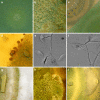Biology and biotechnology of Trichoderma
- PMID: 20461510
- PMCID: PMC2886115
- DOI: 10.1007/s00253-010-2632-1
Biology and biotechnology of Trichoderma
Abstract
Fungi of the genus Trichoderma are soilborne, green-spored ascomycetes that can be found all over the world. They have been studied with respect to various characteristics and applications and are known as successful colonizers of their habitats, efficiently fighting their competitors. Once established, they launch their potent degradative machinery for decomposition of the often heterogeneous substrate at hand. Therefore, distribution and phylogeny, defense mechanisms, beneficial as well as deleterious interaction with hosts, enzyme production and secretion, sexual development, and response to environmental conditions such as nutrients and light have been studied in great detail with many species of this genus, thus rendering Trichoderma one of the best studied fungi with the genome of three species currently available. Efficient biocontrol strains of the genus are being developed as promising biological fungicides, and their weaponry for this function also includes secondary metabolites with potential applications as novel antibiotics. The cellulases produced by Trichoderma reesei, the biotechnological workhorse of the genus, are important industrial products, especially with respect to production of second generation biofuels from cellulosic waste. Genetic engineering not only led to significant improvements in industrial processes but also to intriguing insights into the biology of these fungi and is now complemented by the availability of a sexual cycle in T. reesei/Hypocrea jecorina, which significantly facilitates both industrial and basic research. This review aims to give a broad overview on the qualities and versatility of the best studied Trichoderma species and to highlight intriguing findings as well as promising applications.
Figures

Similar articles
-
The transcription factor ACE3 controls cellulase activities and lactose metabolism via two additional regulators in the fungus Trichoderma reesei.J Biol Chem. 2019 Nov 29;294(48):18435-18450. doi: 10.1074/jbc.RA119.008497. Epub 2019 Sep 9. J Biol Chem. 2019. PMID: 31501242 Free PMC article.
-
Heterologous protein expression in Hypocrea jecorina: a historical perspective and new developments.Biotechnol Adv. 2015 Jan-Feb;33(1):142-154. doi: 10.1016/j.biotechadv.2014.11.009. Epub 2014 Dec 3. Biotechnol Adv. 2015. PMID: 25479282 Review.
-
Familiar Stranger: Ecological Genomics of the Model Saprotroph and Industrial Enzyme Producer Trichoderma reesei Breaks the Stereotypes.Adv Appl Microbiol. 2016;95:69-147. doi: 10.1016/bs.aambs.2016.02.001. Epub 2016 Mar 21. Adv Appl Microbiol. 2016. PMID: 27261782 Review.
-
The cargo and the transport system: secreted proteins and protein secretion in Trichoderma reesei (Hypocrea jecorina).Microbiology (Reading). 2012 Jan;158(Pt 1):46-57. doi: 10.1099/mic.0.053132-0. Epub 2011 Nov 3. Microbiology (Reading). 2012. PMID: 22053009 Review.
-
Sexual development in the industrial workhorse Trichoderma reesei.Proc Natl Acad Sci U S A. 2009 Aug 18;106(33):13909-14. doi: 10.1073/pnas.0904936106. Epub 2009 Aug 10. Proc Natl Acad Sci U S A. 2009. PMID: 19667182 Free PMC article.
Cited by
-
Recent Progress on Systems and Synthetic Biology Approaches to Engineer Fungi As Microbial Cell Factories.Curr Genomics. 2016 Apr;17(2):85-98. doi: 10.2174/1389202917666151116212255. Curr Genomics. 2016. PMID: 27226765 Free PMC article.
-
Trichoderma Biodiversity of Agricultural Fields in East China Reveals a Gradient Distribution of Species.PLoS One. 2016 Aug 2;11(8):e0160613. doi: 10.1371/journal.pone.0160613. eCollection 2016. PLoS One. 2016. PMID: 27482910 Free PMC article.
-
Re-annotation of the CAZy genes of Trichoderma reesei and transcription in the presence of lignocellulosic substrates.Microb Cell Fact. 2012 Oct 4;11:134. doi: 10.1186/1475-2859-11-134. Microb Cell Fact. 2012. PMID: 23035824 Free PMC article.
-
Trichoderma as a biological control agent: mechanisms of action, benefits for crops and development of formulations.World J Microbiol Biotechnol. 2023 Aug 3;39(10):269. doi: 10.1007/s11274-023-03695-0. World J Microbiol Biotechnol. 2023. PMID: 37532771 Review.
-
Context-Dependent Effects of Trichoderma Seed Inoculation on Anthracnose Disease and Seed Yield of Bean (Phaseolus vulgaris): Ambient Conditions Override Cultivar-Specific Differences.Plants (Basel). 2021 Aug 23;10(8):1739. doi: 10.3390/plants10081739. Plants (Basel). 2021. PMID: 34451784 Free PMC article.
References
-
- Adrio JL, Demain AL. Fungal biotechnology. Int Microbiol. 2003;6:191–199. - PubMed
-
- Alanio A, Brethon B, Feuilhade de Chauvin M, de Kerviler E, Leblanc T, Lacroix C, Baruchel A, Menotti J. Invasive pulmonary infection due to Trichoderma longibrachiatum mimicking invasive Aspergillosis in a neutropenic patient successfully treated with voriconazole combined with caspofungin. Clin Infect Dis. 2008;46:e116–e118. - PubMed
-
- Antal Z, Kredics L, Pakarinen J, Doczi I, Andersson M, Salkinoja-Salonen M, Manczinger L, Szekeres A, Hatvani L, Vagvolgyi C, Nagy E. Comparative study of potential virulence factors in human pathogenic and saprophytic Trichoderma longibrachiatum strains. Acta Microbiol Immunol Hung. 2005;52:341–350. - PubMed
-
- Antal Z, Varga J, Kredics L, Szekeres A, Hatvani L, Manczinger L, Vagvolgyi C, Nagy E. Intraspecific mitochondrial DNA polymorphism within the emerging filamentous fungal pathogen Trichoderma longibrachiatum. J Med Microbiol. 2006;55:31. - PubMed
-
- Baek JM, Kenerley CM. The arg2 gene of Trichoderma virens: cloning and development of a homologous transformation system. Fungal Genet Biol. 1998;23:34–44. - PubMed
Publication types
MeSH terms
Substances
Grants and funding
LinkOut - more resources
Full Text Sources
Other Literature Sources

